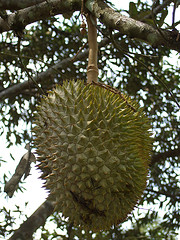Durian
| Infobox on Durian | |
|---|---|
| Example of Durian |  |
| Freshness facts | |
| Optimum carrying temperature | 13°C to 15°C |
| Highest freezing point | - |
| Acceptable product temp. at loading into containers | Max. 2°C above carrying temperature |
| Optimum humidity | 85% to 95% |
| Ventilation setting for containers | 10 m³/hr |
| Storage life | 3 to 5 weeks |
| Climacteric / non-climacteric | Climacteric |
| Ethylene production | See text |
| Ethylene sensitivity | See text |
| Modified / controlled atmosphere | 5%-15% CO2; 3%-5% O2 |
| Potential benefits | Reduced O2 - good; increased CO2 - moderate |
| Availability | |
| April - July | May-October |
Durian
Contents
Harvesting and handling
The Durian fruit is a large, spiny capsule that opens into five segments containing seeds covered with a pulpy, edible aril. External colour changes with maturation from dull olive-green to light yellowish-green. When mature, the fruit drops to the ground, but it can be carefully harvested before this occurs and ripened in 4 to 6 days. Ease of fruit abscission can be used as a maturity index. Fruit is picked with peduncle attached.
The overall smell of the ripe Durian has three distinct aromas: one strong and onion like, one delicate and fruity, and one offensive smell (due to hydrogen sulphide and diethyldisulphide).
Quality criteria include a pulp with sweet flavour and good texture, few or small seeds, large aril percentage and marketable weight, elongated to round shape, good shelf-life, good rind colour and thickness, reduced rind dehiscence and freedom from disease and insects. Superior varieties have thick, yellow, fibreless, and firm pulp.
Cooling and storage
This climacteric fruit, when stored at 15°C, has extended shelf-life. Relative humidity of 85% to 95% is best.
Fruit can be waxed to reduce water loss. Fruit ripened at a lower relative humidity (75%) have a better eating quality that is less juicy and easier to dehusk than fruit ripened at higher relative humidity.
The pulp of half to near full ripe fruit is much less sensitive to chilling injury than the peel, and the pulp can be stored for 4 weeks at 5°C. Whole fruit stored at less than 15°C develops chilling injury shown by the peel turning black or dark brown starting at the groove between the splines. Chill injured pulp suffers a loss of aroma, does not soften and may develop sunken areas on the surface.
Ethylene aspect
Ethylene treatment can accelerate ripening and dehiscence of mature but unripe durians and ethylene scrubbing can delay their ripening.
Mixed loads
Durian produce a sulphurous odour as they ripen, that will be absorbed by other commodities. They should not be shipped in mixed loads.
Cautions
O2 below 2% can result in failure to ripen and grey discoloration of Durian pulp. High CO2 (above 20%) can be damaging.
Storage disorders
Bacterial rots, Phytophthora.











